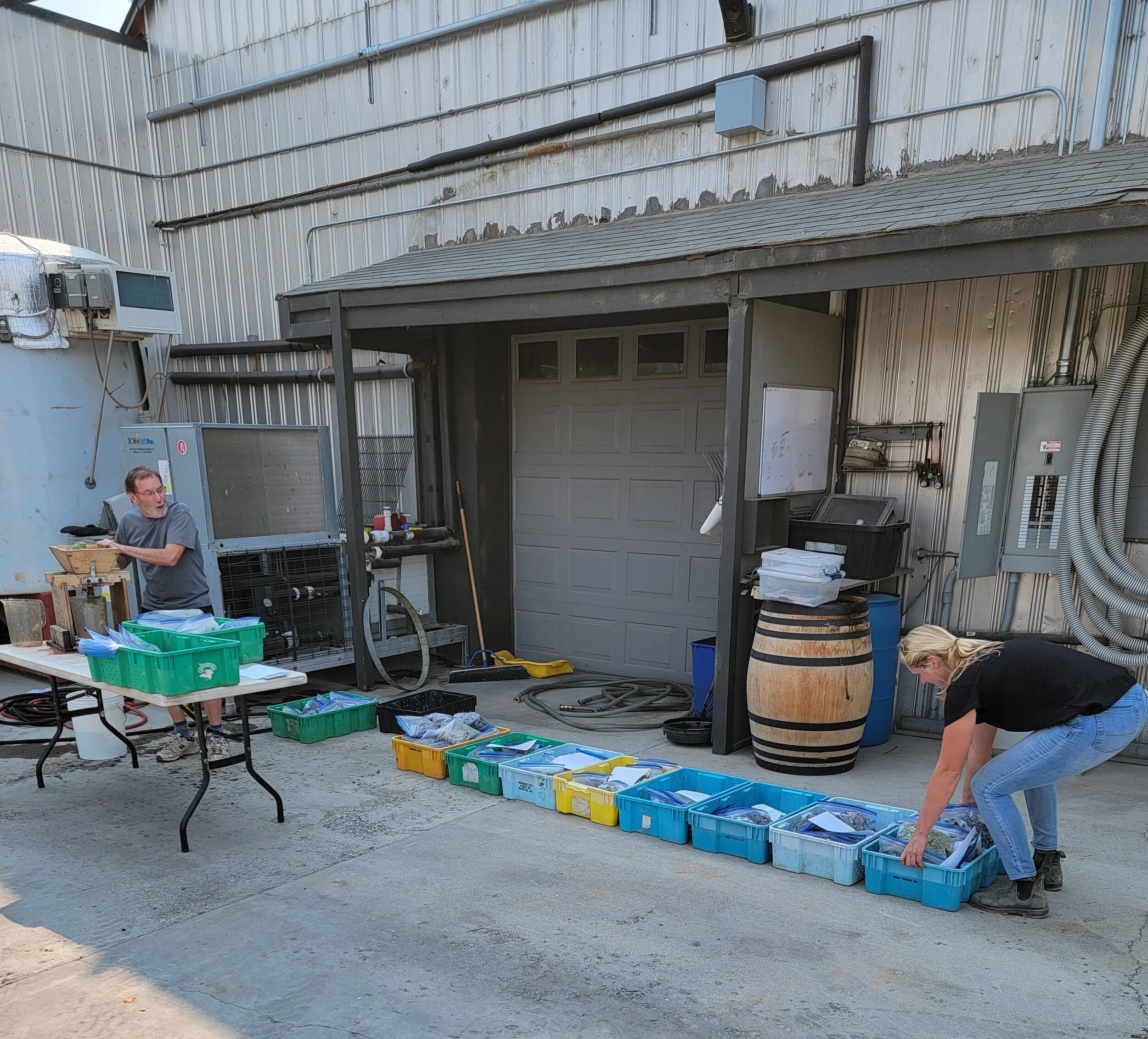You Gotta Know When to Hold ‘Em, Know When to Pick ‘Em, Part 2
Welcome back to the second part of us trying to explain how we know when to harvest! To recap Part 1: we’ve been out sampling every vineyard, gathering twenty clusters per bag to compose a representative sample for each site (multiple blocks/varieties may be sampled at each vineyard but any given Ziploc will contain the same block and same variety). Now we’re back at the winery with heaps and heaps of Ziplocs lined up waiting for...what are they waiting for?
Line ‘em up, Ella!
That’s where “Lab Guy Steve” comes in with this super sophisticated gadget we call “Grandma Phyll’s Fruit Crusher.” No joke, Grandma used this aptly-named device back in the day to process all sorts of fruit that was grown on the farm. It’s kind of neat to have kept this relic in use, especially when so much on the farm has changed.
Steve works out his biceps on Grandma’s vintage fruit crusher
Steve runs the clusters through the crusher and back into the Ziploc bag. Whites are tested immediately while reds go to the fridge to hang out for 24 hours or so. Basically what we are trying to do is mimic the process of crushing/pressing grapes in order to provide meaningful data to our winemaking team and to our grape customers. So, with white grapes, we would crush and press them immediately, while red grapes will usually be crushed and then begin the fermentation process about 24 hours later. So waiting a day provides the most accurate insights into the chemistry of the must (the freshly crushed grape juice which includes stems, seeds, skins) prior to starting fermentation.
What are we testing for? Simply put, sugar and acid. Sugar will be converted to alcohol while acid content affects taste, color, and susceptibility to microbial spoilage.
In a grape, sugar levels are measured in Brix (°Bx), which are expressed in degrees: one degree equals one gram of sugar per 100 grams of grape juice. We use a refractometer to measure the the Brix in the crushed grape solution. Refractometers come in two versions- one that you hold up to your eye like a science-y pirate and one that sits on the counter and gives you a digital readout. We generally use the latter for ease and convenience, but both are effective and accurate.
Matt will be the first to remind us that higher Brix (i.e., more sugar content aka sweetness) does not necessarily correlate to ripeness or readiness of grapes or future flavor/quality of the wine. That’s why we also measure acid. Acid balances the sugary-sweetness of fruit, contributes to phenolic development (chemical compounds that affect taste, mouthfeel, color) and will eventually be what helps the wine age and avoid spoilage.
Acid in grapes (and later, wine) is evaluated in two ways, one or both of which is considered by winemakers when determining when to pick because of the effect on the resulting wine. Titratable acidity (TA) is a measure of the acid content (grams/L) while pH is the measure of acid strength in comparison to everything else in the solution. To put it simply: TA is most useful in predicting how a wine will taste and feel while pH will allude more to the stability of the wine.
Remember those pH strips we used in school? Yeah, we don’t use those- we are testing too much and it gets expensive! Instead, we use a pH meter with a probe that we stick into the solution. TA is measured by titrating the sample with an alkali solution.
Once Steve has all the numbers for a lot, he uploads that information to a portal where it can be accessed by those who need to know (primarily winemakers). And remember how we said he would probably quit if we tested every variety from every block every day? Now you know why.
Great, now we know HOW to sample and test, but the question remains: HOW DO WE KNOW WHEN TO PICK?
This is why we like to say winemaking is both a science AND an art. There is no specific formula, and not every winemaker’s objective is the same. That’s why we monitor so many data points, track trends, and consider previous vintages- to allow everyone to make the best decision for their winemaking program. Basically, think of winemakers like Goldilocks- they want the best grapes that are juuusssst right (for them).
Yeah, yeah, I get it but can you pleeeease just give us some numbers?
Okay, okay. So, in general, red grape varietals are not picked until at least 23.5 °Brix, whites at or above 21 °Brix. On average, pH is between 3.0 and 4.0, usually right in the middle. TA varies a little more depending on style of wine, but we say around 6.0-7.0 g/L for reds, 6.0-9.0 g/L for whites..
As you can see, the overarching theme is “IT DEPENDS.” And that’s why Patrick’s phone is almost always ringing/buzzing with notifications during harvest.
If you take nothing else away from this lesson, just remember, there is no chemical equation for a good wine. And also why no two wines are ever the same, which is all part of the fun!


